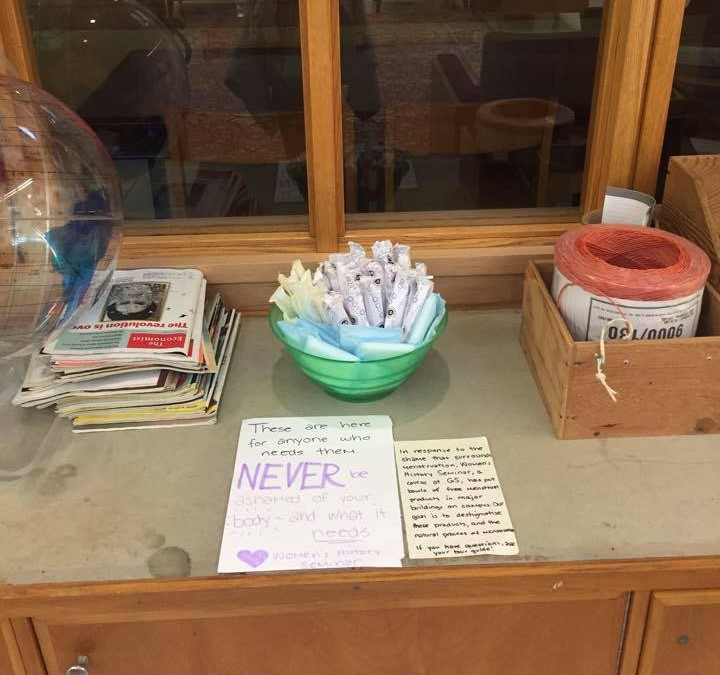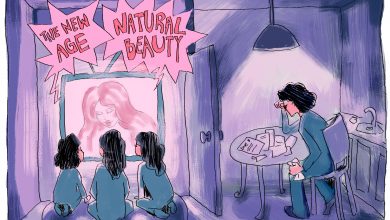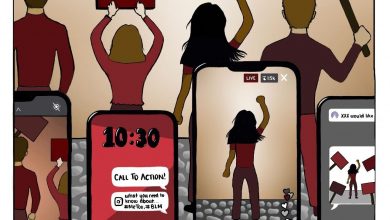MPE: A Movement Fighting The Stigma Against Menstruation in American High Schools

Image: The MPE team, by Vienna Vernose
In 2015, the American conversation around menstruation and the stigma attached to it got louder and more widespread. In September, authorities deemed period-underwear brand Thinx’s ad campaign too “offensive” to be displayed on the subway in New York City, and the backlash was instant. Prominent celebrities made a video speaking out against period-shaming. In April, Kiran Gandhi ran a marathon while free-bleeding, a move that was met both with repulsion and praise. Gandhi also visited the UCLA campus in September to facilitate the first installment of CAC’s “Let It Flow” Culture Talks, a discussion that attempted to unpack the stigma against menstruation.
And this movement is not limited to liberal college campuses and celebrities; high schoolers around the US are also speaking out against the stigma in their schools. One such teenager is Vienna Vernose, a reader of FEM who recently approached us about the powerful movement she’s spearheading with other students in her Women’s History Seminar at George School in Newton, Pennsylvania.
The movement is called MPE, or Menstrual Product Equality, and I had a discussion with her about their efforts and goals. “I take a class at my school called Women’s History Seminar,” she explained, “And I find it to be a class where I am comfortable voicing my opinions … I came in one day from a chemistry class where someone had yelled ‘ew’ when a tampon had fallen out of my backpack, and I was very offended by it. I brought it up to my [Women’s History Seminar] and I came up with the idea [of] having to neutralize your period, and instead of hiding it and feeling shame, we could put these bowls of tampons and pads with a little note describing our movement out in the open to make a point.”

Vienna’s experience of being met with disgust is one that is common to a lot of folks who menstruate, more so to those who are “not supposed” to menstruate, such as trans men. Her movement’s primary goal is education about menstruation and the spread of awareness about unfair taxation on tampons and pads. “We put the bowls out in a few different buildings around our campus around the time of our school’s open house,” she said. “We received complaints from our admissions office saying that prospective students’ parents would be appalled by this but we refused to take them down, saying that it would be completely against everything we are doing to take down these bowls for the comfort of other people.”
She has created a task force in student government to tackle complaints and other issues. Their English department forbade them to place a bowl in their building, surprisingly enough. Whatever happened to artsy liberalism? “The head of our English department started taking them out of other buildings,” Vienna said. “Later we replaced them … We had many students taking pictures of the bowls, Snapchatting it to people and saying ‘what’s wrong with my school.’ Luckily, we haven’t received any punishment for it … I’m lucky to go to a school that is accepting, but there are always teachers and students who won’t understand your motives.”
The backlash and lack of understanding affects other social movements in their school too, according to Vienna, such as the Black Lives Matter movement, which was met with “All Lives Matter” posters around the campus. It’s unfortunate that this is not something that can be blamed solely on childish, teenage ignorance; we even faced something similar at UCLA when there was a pushback against black students organizing against on-campus racism. But Vienna says that she’s realized that confrontation that might make people uncomfortable is the key to social change and starting conversation–and in 2016, tampons and pads are still a controversial issue. Even the common term for them–“feminine hygiene products”–is one that is euphemistic, sexist, and trans-exclusionary, and yet it persists in our lexicon. “I hate the word,” Vienna wrote. “We have refused to use those types of phrases in our movement because it essentially masks the truth with a more socially correct term to make people feel more comfortable.”
In addition to starting a necessary conversation about this issue, the MPE movement is making the best of modern technology to improve the facilities at their school. “A few of the people in our class are on our student council, where they have been working directly with our school board,” Vienna explained. “We have been working on creating 3D printed tampon dispensers that don’t require payment. We are designing them ourselves with our 3D printers because there’s nothing on the market that is in a suitable price range and has a design we think would work. We’re figuring out where single occupancy bathrooms and women’s bathrooms are on campus, we polled people to figure it where they want/need products, and also getting money for funding all our projects. So far, we have about 1500 [US dollars] donated to the program which should take us throughout the year before my school needs to pay anything.”
The movement is also not limited to one school–Vienna has tentative plans on creating a network to start a wider movement. “So my rough plan [is], once we complete some things at my school, to have a formal letter written explaining our intentions and what we’ve completed, and sent out to the student councils of different high schools in my area. Social media is a very powerful tool, so I’m also trying to document what we are doing through social media so different young people can maybe get inspired by this. I would love to go to schools with my class and give a talk about what we are doing but I think that is a reach and unfortunately, I’m not sure how seriously we would be taken.” I encouraged her to do it–it would be a shame to let such a vision slip away just for the fear of ridicule, which I do not believe they will face. The conversation about menstruation is one that is here to stay.
In our discussion, Vienna also made an important point about our voices and how we can use them. She said, “Before this incident, I would hide my beliefs because I was afraid I was going to make someone angry or offend someone, but holding back my voice wouldn’t change anything. If I can’t verbalize what I believe in, I simply blend into the stereotype I wish to change. This movement made me realize that we don’t just have a voice for speaking, we have a voice that can leave an imprint on the world, and I intend to use it. And I hope others will take this and maybe shed their fear of verbalizing what they believe in.”
This idea is so, so important–we must realize that this fear of angering someone is another way in which power, patriarchal or otherwise, acts upon us. Of course, we must at the same time be aware that being able to use our voices and be heard is a privilege in and of itself–for many people, speaking out about their experiences could have serious consequences that go beyond mean internet comments, such as termination from their jobs, or even death. But if we can use our voices, we must. American society likes to pretend that racism, sexism, and other forms of oppression don’t exist, but we must realize that this denial is the primary way in which privilege is upheld.
The fact that the MPE movement is comprised of high-schoolers makes it all the more significant that they are speaking out. Their dedication and hard work fight the commonly-held notion that young people – that is, pre-college folks – cannot engage in meaningful activism. We at FEM think it’s awesome that Vienna and her friends not only recognized the problem, but also took drastic steps to combat it! Apathy is one of the greatest setbacks to social change – but the more we support and talk about movements like MPE, the more strength and momentum we provide to ongoing revolution.




